Last Updated on January 18, 2024 by Greg Gillson
Northern Cardinals live in woodlands and backyards in the eastern and southern United States. They are resident birds; they do not migrate. Thus, they nest in the same areas where they are found in winter.
Do you have Northern Cardinals at your feeders in winter but don’t see them in summer? There are some things you can do to make your yard more attractive to nesting cardinals.
Female Northern Cardinals build their cup nest in dense thickets and vines.
This page is a supplement to my Overview page on attracting Northern Cardinals. That overview page leads to other pages on food and diet, range and habitat, and identification. This page discusses nesting and reproduction.
 |
|
Female Northern Cardinal feeding her fledgling
Image by Scottslm from Pixabay
|
Nesting habits and reproduction of Northern Cardinals
The nesting season for Northern Cardinals in the United States runs from March to August. Cardinals raise from one to four broods each year, though usually two to three at most.
Pair bonds are usually strengthened through the winter for those birds who retain the same mate. Otherwise, courtship begins in the early spring for those selecting new mates. Males start singing in mid-February in the north part of their range. Singing may occur year-round in more southerly locations.
The female builds the nest and incubates the eggs. Both males and females feed the young. After the young fledge the male takes care of them for a couple of weeks until they are on their own. The female, however, goes right back to work. She builds a new nest and lays another clutch of eggs. Then the male returns to help again with the new nestlings and fledglings.
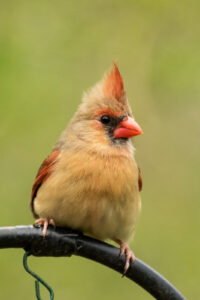
Courtship and mating
Male Northern Cardinals start singing more frequently in late winter, declaring their territory from a tall open perch.
Songs are learned by young birds from the male parent as well as other birds singing locally during the previous breeding season. Songs thus vary across the range of the species. All are recognizable, though, as belonging to the cardinal.
The song is made of loud repeated clear single or doubled whistles. It sounds to some people like whoit-whoit-whoit, birdy-birdy, cheer-cheer, or other similar notes in varied combinations.
They defend their territories vigorously from other males. Fights between male cardinals on adjacent territories are common. The males are so aggressive that they even attack their own reflections. You may see them battling their reflections in windows and external car mirrors. In the past they attacked reflections in car hub caps, though car wheel designs have changed in recent years. They may return every morning to attack the reflection they couldn’t vanquish the day before.
Female Cardinals also sing. The song is softer than the males. Sometimes the male and female of the pair sings together. The female cardinal also sings from the nest.
Some courtship activities include the male feeding seeds to his mate. Since the bills touch briefly, this has been called a kiss.
Other courtship behaviors include raising one wing and the head crest. A similar behavior includes raising one wing, lowering the crest and swaying back and forth. Sometimes the male performs a short hop-flight toward his mate, flying slowly and singing with crest raised and plumage fluffed fully.
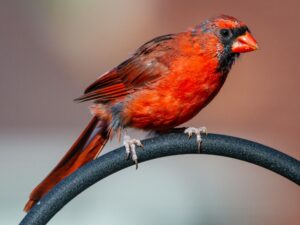
Nest building
The female Northern Cardinal does most of the nest building. The male may bring some nest material to her, though.
The nest is usually built in the fork of a branch of small tree or dense bush. Thick vines such as honeysuckle, rose bushes, or young conifer trees are common plants in which cardinals build their nests. You may encourage cardinals to nest in your yard if you have such dense shrubby plants for them to hide away their nests.
Nests may be built as low as 2 feet off the ground, up to 12 feet high. Most are 4-5 feet off the ground, though.
The cup-shaped nest is made from twigs, weed stems, bark strips, pine needles, grass, and leaves.
Even though cardinals nest multiple times in a season they usually do not reuse their nests. The female builds a new nest each time.
Nest boxes
Northern Cardinals do not use enclosed nest boxes. They may, however, use an artificial nesting shelf.
A 3-sided nest box or a simple shelf may be accepted as a nesting platform by Northern Cardinals or American Robins.
These should be hidden and concealed in a shrubby plant or vine. Place them 4-5 feet high. They should be placed so that they are shielded from afternoon sun. I know you want to look at the nest, but it should be as concealed as possible so that predators don’t eat the eggs or nestlings. Predators include house cats, jays, crows, raccoons, etc.
If the female cardinal likes the location, she will build her nest in the box. Clean it out after the season is over. She may reuse the box later in the same season or the next year. If you put the nest shelf out in early winter they may use it right away the first spring. Otherwise you may need to wait until the following spring for them to discover and get used to it.
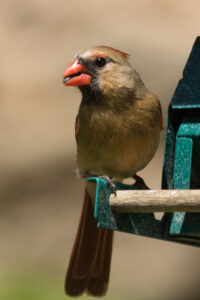
Eggs
Cardinals lay their eggs from March to August. Northern birds don’t start nesting any later than southern ones. This range accounts for 2 or more nesting attempts.
The number of eggs laid per clutch is usually about 3-4 eggs. Clutch sizes range from a low of only 2 eggs to a high of 5 eggs.
Northern Cardinal eggs are about 0.9-1.1 inches long. Eggs are gray, buff, or greenish-tinged. They are spotted with brown, gray, and purple markings, especially on the larger end of the egg.
The female does most of the incubation for 11-13 days before the eggs hatch. The male feeds the female while she incubates the eggs.
Young–nestlings and fledglings
Young cardinals at hatching are naked except for small tufts of down. The eyes are closed. They are very helpless and clumsy. The only act they can perform at first is raising their heads with mouths wide open and peeping for food.
Both parents feed the young. The mother cardinal continues to spend quite a bit of time in the nest with the nestlings, keeping them warm or cool, depending upon need.
Though the adults mostly eat seeds, they feed insects to the nestlings.
Nestlings grow brownish juvenile feathers while in the nest. The young are ready to leave the nest about 10-11 days after hatching. They soon start molting again (preformative molt), slowly getting new adult-like feathers. Young males may have patches of new “adult” red feathers and patches of brown juvenile feathers. These “hatch year” birds slowly get a reddish bill after starting with a gray bill.
Now it’s the father’s turn. Males care for the recent fledglings for a week or so until they are able to fly and take off on their own. Then the male returns to his mate who has started nesting again. By this time she has built a new nest and laid eggs that may be ready to hatch soon.
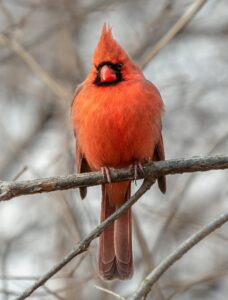
Back to the overview page for Northern Cardinals.
Wrapping Up
There are many reasons why Northern Cardinals are considered special birds! Here are just a few:
1. Striking Appearance:
The male’s fiery red plumage is a showstopper, especially against the backdrop of greenery or snow. The contrast with the female’s more subtle brown and red hues further adds to their visual appeal.
Both males and females sport a prominent crest on their heads, adding a touch of regality and personality.
Their thick, conical beaks hint at their powerful seed-crushing abilities and add a touch of ruggedness to their overall look.
2. Melodious Songs:
Both males and females sing, with males boasting particularly complex and beautiful songs. Their repertoire includes whistles, trills, and gurgling sounds, often used to attract mates, defend territories, and communicate with each other.
Their songs are a familiar and cherished sound in many parts of North America, instantly evoking a sense of peace and tranquility.
3. Year-Round Residents:
Unlike many other songbirds that migrate south for the winter, Northern Cardinals are non-migratory in most of their range. This means you can enjoy their presence year-round, adding a splash of color and song to your backyard or local park.
Their presence during colder months offers a welcome contrast to the bare winter landscape and brings a bit of cheer to the season.
4. Cultural Significance:
Northern Cardinals have been symbols of love, passion, and loyalty throughout history. They are often featured in songs, paintings, and literature, solidifying their cultural significance.
In many places, they are considered a good omen and their presence is associated with hope and good fortune.
Frequently Asked Questions
What birds are related to the Northern Cardinal?
The Northern Cardinal belongs to the Cardinalidae family, also known as the cardinal grosbeaks, which consists of a diverse group of songbirds found primarily in the Americas. Here are some of the closest relatives of the Northern Cardinal within this family:
Pyrrhuloxia: Resembles a smaller, duller version of the male Northern Cardinal with a reddish face and brown body. Found in the southwestern United States and northern Mexico.
Rose-breasted Grosbeak: Male boasts a bright rose breast and black head, while females are streaked brown. Breeds in North America and migrates south for the winter.
Black-headed Grosbeak: Male has a black head and chest with a yellow breast, while females are brown and streaked. Found in western North America.
Why are male and female Northern Cardinals such different colors?
The stark difference in plumage between male and female Northern Cardinals, with males sporting a fiery red coat and females clad in subtle browns and reds, is a phenomenon rooted in evolution and serves several key purposes:
The vibrant red plumage of the male acts as a powerful visual signal to attract mates. Females are drawn to males with brighter red colors, perceiving them as healthier, stronger, and better providers for potential offspring. This preference favors the passing on of genes for brighter coloration in male offspring, leading to the intensification of the red hue over generations.
In contrast, the female’s cryptic brown and red hues provide camouflage while nesting and caring for chicks. Predators are less likely to spot them on the ground or amidst foliage, increasing the survival chances of offspring and ensuring reproductive success.
What is the US range of the Northern Cardinal?
The Northern Cardinal boasts an impressive range across the United States, encompassing diverse habitats and extending into neighboring countries. Here’s a breakdown of their distribution:
Core Range:
- Eastern North America: From southeastern Canada in provinces like Ontario and Quebec, through the eastern United States, spanning from Maine in the north to Florida in the south, and west to Minnesota and Texas.
- Southwest: Parts of southern Arizona and New Mexico.
Additional Presence:
- Introduced populations: Northern Cardinals have been introduced and established breeding populations in Hawaii, southern California, and Bermuda.



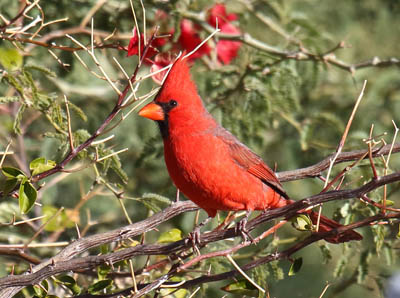
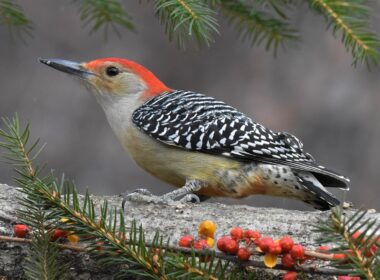
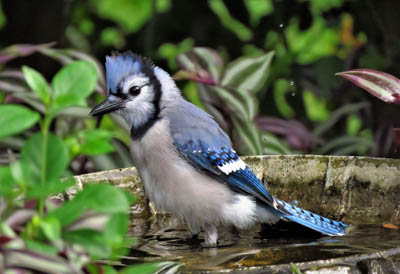
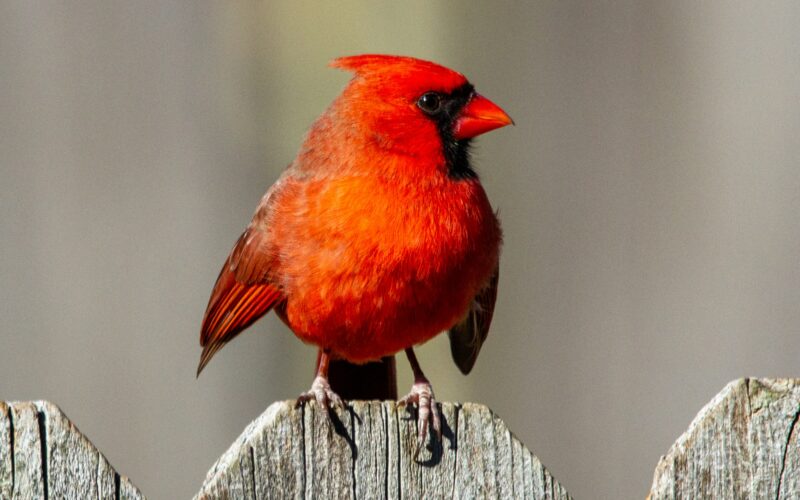
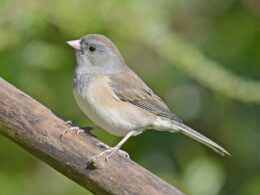
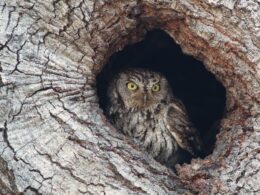
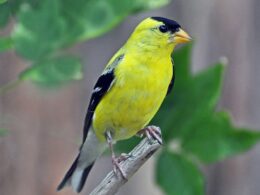
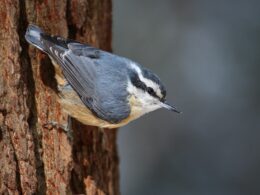
Thanks for the info about nesting boxes/shelves. I have several Cardinals that are regulars at my feeders but wasn’t sure if they’d nest nearby, Great video!
Its a great pleasure reading your post.Its full of information I am looking for and I love to post a comment that "The content of your post is awesome" Great work. Birdwatching
Thanks Brett.
Your recent article on squirrels at bird feeders is amazingly thorough.
Hello! I have a hanging fern on my front porch with a cardinal nest. Will the porch light light at night bother it (momma and babies)? I’d turn off if a “turn off” to momma. She just built the nest two days ago.
Hello! I have a hanging fern on my front porch with a cardinal nest. Will the porch light light at night bother it (momma and babies)? I’d turn off if a “turn off” to momma. She just built the nest two days ago.
td,
I don't think the light will make much difference, either way. Just use it the way you usually do and the birds will accept it.
This was interesting and informative. I've had Cardinals nesting in a vine next to the house. This year there are 5 eggs. Hopefully they all hatch. I saw what looked like a cat bird stalking the nest. The Cardinals have come to trust this same area the last several years.
Sounds like a nice yard for birds!